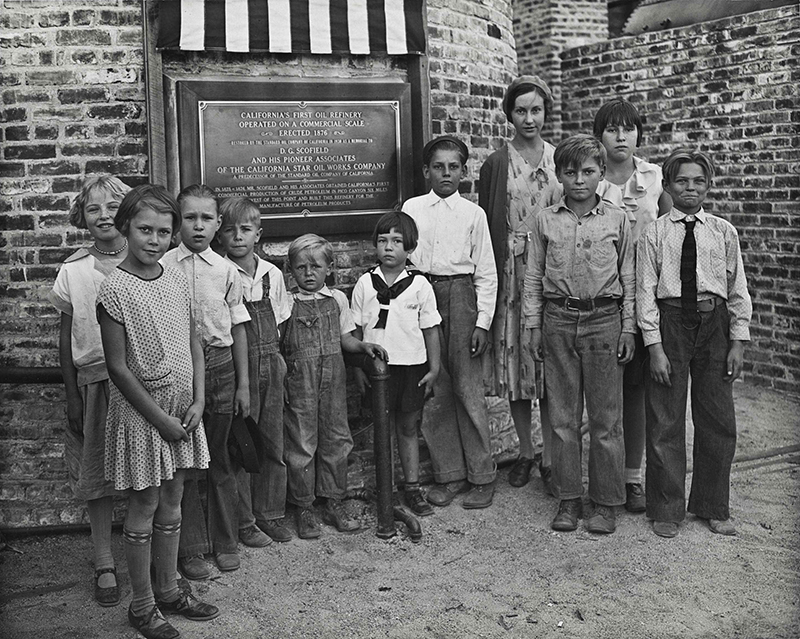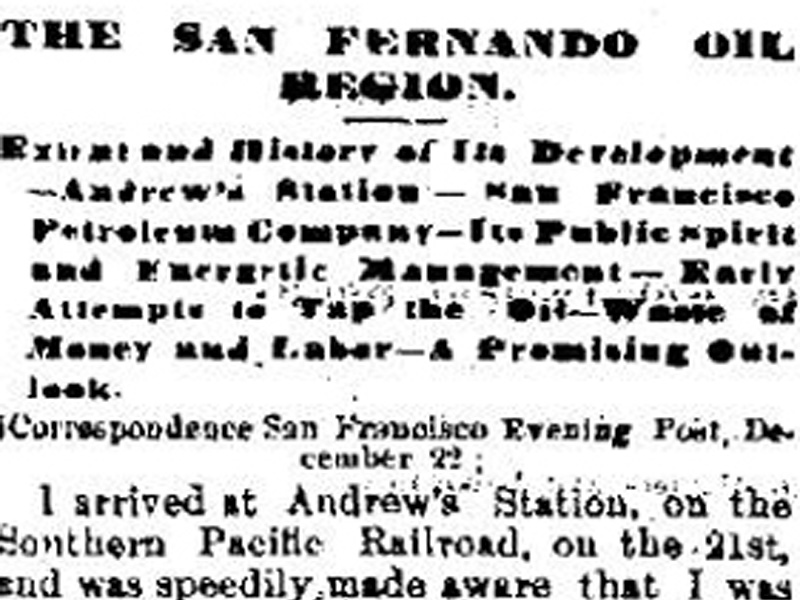|
|


Click image to enlarge
November 5, 1930 — Children of Pico Canyon oil workers gather in front of the plaque that has been affixed to the 120-barrel cheesebox still at the dedication of the newly restored Pioneer Oil Refinery off of Pine Street in Newhall. Above and behind them is an American flag that has been draped over the still as seen here. From left, the children are Leena Stearns, Barbara Sitzman (foreground), Josh Wooldridge Jr., Bud Dill, Jimmy Stearns, Nicolene Cheney, Phil Sitzman, Freida Brown, Ted Dill, Ruth Wooldridge and Elden Stearns. Barbara Sitzman, second from left, is Barbara Emma Sitzman (later Cook) (1921-2002), daughter of Standard Oil Co.'s Pico Canyon superintendent Charles E. Sitzman. Phil, her older brother, is Philip Edward Sitzman (1920-1993). Here, the refinery is being dedicated to the memory of pioneer oil man D.G. Scofield, founder of California Star Oil Works, which hired Alex Mentry to bring in the wells in Pico Canyon. The refinery was in sad shape prior to the restoration, but all four boilers were present and the chimneys, which had fallen, were rebuilt. The refinery was restored again in the 1950s (by then, the two smaller boilers had been removed) and in 1976 (coinciding with Pico's centennial and the nation's bicentennial). The refinery was heavily damaged in the 1994 earthquake. In 1997, Standard (as Chevron) gave the refinery property to the city of Santa Clarita. The city indends to restore it once again and turn the surrounding acreage into a public park, but as of 2015 the plan languishes on the city's "unfunded projects" list. Note: This is a different example of an identical image in the SCV Historical Society's Charles E. Sitzman collection. About the Pioneer Oil Refinery.
About the Pioneer Oil Refinery. The Pioneer Oil Refinery on Pine Street in Newhall dates to 1877, when oil driller Alex Mentry was breaking new ground in Pico Canyon and Chinese track layers had just finished hammering rails through Henry Newhall's recently purchased rancho. The little 15-barrel still that had been erected in 1874 at Lyon's Station (now Eternal Valley Cemetery) just wasn't working out. It couldn't produce a smoke-free kerosene — oil's major use in those days — and in 1875 it was shut. Besides, it was almost a mile away from the coming railroad. Andrew Kraszynski's brand-new stagecoach stop at the mouth of Railroad Canyon made the ideal location for a new refinery. Not only did it have a bountiful supply of water for refining operations, but it sat right next to the train tracks. John A. Scott, an experienced refiner from Pennsylvania, supervised construction. Scott moved the little 15-barrel still and another 20-barrel still from Lyon's to Andrew's and added a large, 120-barrel cheesebox still. Completed in August 1877, the refinery was an instant success. Meanwhile, up at Pico, Alex Mentry had resumed his well-deepening campaign, which had stalled out after a water shortage. Mentry laid a pipe from a water source in a neighboring canyon for his steam drilling machinery. Within two months he was producing more oil than the Pioneer refinery could handle, so a fourth and even larger 150-barrel cheesebox still was added. Oil itself was used in the distillation process. Heavy residual oil from earlier refining runs fueled the brick ovens beneath the stills. Tall brick chimneys vented what must have been massive amounts of smoke. Petroleum gasses passed into a condenser consisting of a wooden box with 1,400 feet of layered iron pipe submerged in water. The condensed oils flowed into a lead-lined agitator, where they were treated with chemicals and mixed with air to improve their burning quality. The Pioneer Oil Refinery at Andrew's Station added benzene and illuminating oil for ships, railroads, factories and mines to California Star Oil's list of products. The breadwinner, though, was clean-burning kerosene in two grades. Within a few years, oil was flowing all along the California coast. A huge refinery was set up at Alameda, directly across the bay from San Francisco — a much more practical location than the little burgh of Newhall. In 1888, the refining operation at Andrew's Station ceased for all time. For about a dozen years, the Pioneer Oil Refinery off of Pine Street served to light up the western frontier. It was the first commercially successful oil refinery in the Western United States and is believed to be the oldest existing refinery in the world. Today its idle smokestacks and empty stills cast long shadows on the dawning of California's oil industry — an industry whose roots are intertwined with those of the Santa Clarita Valley. The Pioneer Oil Refinery in Newhall is State Historical Landmark No. 172. — Leon Worden 1997 Notes: The city of Santa Clarita acquired the Pioneer Oil Refinery property as a gift from Chevron USA in 1997 (escrow closed in April 1998) with the intent of restoring it and turning it into a public park. Funding was/is to come in part from developer fees associated with the Gate-King ("Needham Ranch") Industrial Park, which would surround it. (The refinery would find itself at the intersection of two roads leading into the business park.) The Santa Clarita City Council approved the buiness park in 2003, but then the development was tied up in court with environmental lawsuits. Construction of the first of three phases of the business park finally commenced in late 2017, fourteen years after approval. In early 2021, while grading for Phase II of the Needham Ranch business park was underway, the City of Santa Clarita began physical work on the restoration of the refinery, beginning with temporary removal of the refinery features in order to stabilize and compact the soil and pour new foundations.
TLP3001: 9600 dpi jpeg.
|
Kraszynski Sues to Recover Land 1874
Description May 1877
Andrew's Station, Refinery Layout
Description Jan. 1877
Workers ~1880
First 2 Boilers
Now in Richmond
Pre-1930 Restoration
News reports: 1930 Restoration
Pico Oilmen, 1930 Restoration
Pico Kids at 1930 Restoration
~1930
FILM: "High, Wide and Handsome" 1937
State Parks/WPA Report 1936
1939 Rose Parade
RPPC ~1940
Rear View ~1940
~1940s x2
1950s
Chevron Donates Refinery 1998
Chevron Restoration Plan (Proposed) 1998
150-bbl Still 2004
Revised Pioneer Oil Park Master Plan 2013
N-Scale Model 2017
|
The site owner makes no assertions as to ownership of any original copyrights to digitized images. However, these images are intended for Personal or Research use only. Any other kind of use, including but not limited to commercial or scholarly publication in any medium or format, public exhibition, or use online or in a web site, may be subject to additional restrictions including but not limited to the copyrights held by parties other than the site owner. USERS ARE SOLELY RESPONSIBLE for determining the existence of such rights and for obtaining any permissions and/or paying associated fees necessary for the proposed use.























